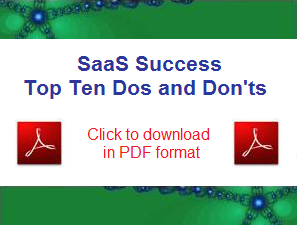
Save it or share it with a colleague.
Click the image above to download the SaaS Top Ten PDF.
For more SaaS business strategy tips,visit or subscribe to Chaotic Flow by Joel York
Or, click below to read the SaaS Top Ten Dos and Don'ts online...
SaaS Do #1 - Choose a Large Market
SaaS Do #2 - Create a Hub on the Web
SaaS Do #3 - Accelerate Organic Growth
SaaS Do #4 - Craft a Compelling Story
SaaS Do #5 - Build the Business into the Product
SaaS Do #6 - Reach across the Firewall
SaaS Do #7 - Monetize Creatively
SaaS Do #8 - Enable Mass Customization
SaaS Do #9 - Open Up to the Cloud
SaaS Do #10 - Leverage Your Community
SaaS Don't #1 - Chase Elephants
SaaS Don't #2 - Waste Money Marketing Offline
SaaS Don't #3 - Launch without Online Trial
SaaS Don't #4 - Cover up Shortcomings with People
SaaS Don't #5 - Invest in Channel Partners too Early
SaaS Don't #6 - Bleed Cash Indefinitely
SaaS Don't #7 - Ignore the Long Tail
SaaS Don't #8 - Think You Can Control It
Software-as-a-Service
Success
The Top Ten Dos and Don’ts of SaaS Business Success
Because B2B SaaS roots lie in office and enterprise software, which have traditionally been delivered on a CD, i.e., like any offline commodity that is physically separate from the business itself, the opportunity to change the game by building your business into the product is one of the most overlooked by SaaS vendors. When you move your software product online into a software-as-a-service delivery model, it enables you to connect the product directly to your customers out on the Web and directly to your internal systems across your firewall, thus allowing you to reengineer your fundamental business processes by building them out from your product.
A great role model for building the business into the product is one of the earliest Internet success stories: Amazon.com. Although most of what you can buy at Amazon is a physical product, the fact that it gets shipped to you is almost an afterthought–you could achieve the same purpose by ordering through a direct mail catalog. What you are really buying when you shop at Amazon is convenience and credibility, and these benefits derive from features of Amazon’s software-as-a-service: Amazon.com. The features include affiliate referrals, product search, offers, recommendations, one-click checkout, order management, support and nurturing. More specifically, Amazon.com automation facilitates the purchase process. Amazon’s affiliate programs spread points of entry (links!) all over the Web, and when you reach Amazon.com, you are naturally led through every stage of the purchase cycle. As a Web-based business, you have the same opportunity to facilitate purchase, service, support, etc. through automation that you build out from your product—driving up revenue, and driving down costs.
Chances are that your business is different from Amazon’s in some fundamental ways, e.g., target customers, product complexity, community involvement, etc. and you will need to tailor your approach to your market. However, the study of other successful Web businesses regardless of their nature offers powerful analogies that you can apply to your own business. For example, crowd-sourcing has become a very popular approach to international translations, but Amazon was building automation to crowd-sourcing the decision stage of the book purchase process ten years ago by encouraging customers to create reviews and top ten lists.